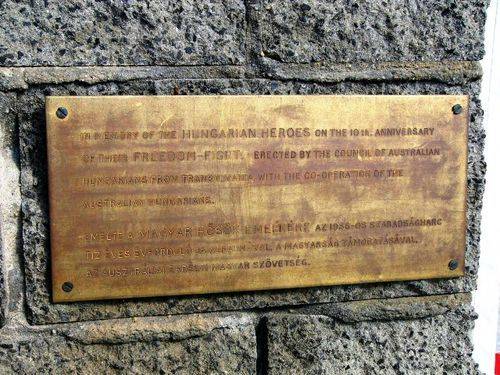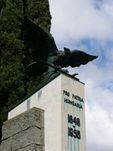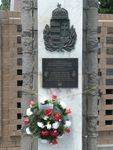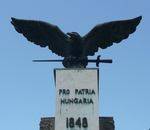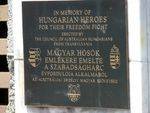
Home » Themes » Government » Dissent
Hungarian Freedom FightersPrint Page 
The monument commemorates Hungarians who died in the Hungarian revolutions of 1848 and 1956. A plaque was unveiled on the monument to commemorate the 10th anniversary of the 1956 revolution.
The bird on top of the monument is the "Turul" which represents the god's power and will. The Turul was seen as the ancestor of Attila, and it was also the symbol of the Huns. It is often represented carrying the flaming Sword of God (sword of Attila), and bearing a crown. This crown is linked to Attila who is traditionally considered the first king of Hungary.
In March 1848, revolution erupted in Vienna, forcing Austria's Chancellor Klemens von Metternich to flee the capital. Unrest broke out in Hungary on March 15, when radicals and students stormed the Buda fortress to release political prisoners. A day later, the Diet's liberal-dominated lower house demanded establishment of a national government responsible to an elected parliament, and on March 22 a new national cabinet took power with Count Louis Batthyany as chairman, Kossuth as minister of finance, and Szechenyi as minister of public works. Under duress, the Diet's upper house approved a sweeping reform package, signed by Ferdinand, that altered almost every aspect of Hungary's economic, social, and political life. These so-called April Laws created independent Hungarian ministries of defense and finance, and the new government claimed the right to issue currency through its own central bank. Guilds lost their privileges; the nobles became subject to taxation; entail, tithes, and the corvee were abolished; some peasants became freehold proprietors of the land they worked; freedom of the press and assembly were created; a Hungarian national guard was established; and Transylvania was brought under Hungarian rule.
In 1956, Communist Hungary was convulsed by a revolution against the Soviet imposed political and economic system. Following a brief period of liberalisation under Imre Nagy, folllowing Stalin`s death in 1953, Hungary`s Communist party returned to a Stalinist line. By the middle of 1956 there was considerable instability in the leadership.
On October 16th University students in Szeged formed an independent league. They were rapidly joined by students from around the country. By October 24th popular demonstrations had led to the collapse of the government. Independent student organisations and workers` councils had formed all over Hungary.
However by early November Soviet tolerance was at an end, and on November 4th Soviet and other Warsaw Pact troops invaded the country. In the resulting counter-revolution strikes were banned, activists were imprisoned and some were executed.
At least 3,000 died and 13,000 were sent to the camps. Over 200,000 fled the country.
Location
| Address: | College Crescent, Melbourne General Cemetery, Carlton North, 3054 |
|---|---|
| State: | VIC |
| Area: | Foreign |
| GPS Coordinates: | Lat: -37.791667 Long: 144.962222 Note: GPS Coordinates are approximate. |
Details
| Monument Type: | Monument |
|---|---|
| Monument Theme: | Government |
| Sub-Theme: | Dissent |
| Approx. Event Start Date: | 1848 |
| Approx. Event End Date: | 1956 |
Dedication
Pro Patria Hungaria
1848 - 1956
Plaque :
In memory of Hungarian heroes for their freedom fight
Erected by the Council of Australian Hungarians from Transylvania
Magyar Hósök Emlékére Emelte A Szabadságharc Évforddulója Alkalmából
Az Austráliai Erdélyi Magyar Szövetség
Plaque :
In memory of the Hungarian heroes on the 10th anniversary of their freedom fight.
Erected by the Council of Australian Hungarians from Transylvania with the co-operation of the Australian Hungarians.
Emelte a Magyar Hosok emeekere AZ 1955 - OS szabadsagharc tiz eves evfordulo ja alkalm val a magyarsag tamogatasaval, az Ausztraliai erdelyi magyar szovetseg.



